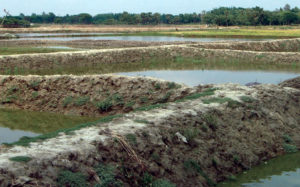
Sulfides alter aquaculture pond pH, can be toxic
Ponds constructed where soils contain sulfides can have problems with low pH in culture water. Liming can be an effective emergency measure.
Management of dissolved oxygen in ponds with static water is difficult, so managers of non-aerated ponds usually limit stocking and feeding rates.

Ponds constructed where soils contain sulfides can have problems with low pH in culture water. Liming can be an effective emergency measure.

Molluscan seed production in China encompasses 32 species. The seeds of most clams are collected from natural sources in farming areas.

Outside optimal salinity ranges, aquaculture species have higher feed-conversion ratios, grow at slower rates, become stressed and susceptible to disease, or even die.

Pesticides, herbicides and fungicides may control pests and noxious vegetation, but environmental and health concerns call for responsible chemical use.

Industrial aquaculture parks that employ hyperintensive culture technology are a promising alternative for further land-based seafood production. They offer wide siting options, efficient land and water resource use, and high-density, high-yield production output. In Project Raceways, a five-nation consortium is developing protocols for the culture of several highly valuable species of marine fish in raceway systems.

In research on collective marketing involving 32 small-scale fish farmers in Cameroon, 12 made a profit, which sparked further local interest in the concept.

Phosphorus from uneaten feed and feces of culture animals can cause excessive phytoplankton growth and associated degradation of water quality.

Floating raceways can be put in ponds, reservoirs, or sheltered waters as small-scale production systems for fingerlings or short-term nursery environments.

In the water of aquaculture systems, certain bacteria transform potentially toxic ammonia to nontoxic nitrate through nitrification.

Freshwater fish culture is practiced in every state in Brazil, primarily at small-scale earthen pond facilities, but tilapia culture in reservoir cages is increasing.

As reflected in a survey by the authors, rising productivity and higher yields have made pangus culture more profitable than carp farming.

To further development of freshwater fish farming in Papua New Guinea, farmers need improved supplies of fingerlings and appropriate training and extension services.

Alkalinity is an index of the capacity of water to neutralize acidity. Hardness represents the sum of calcium and magnesium concentrations. Both values vary greatly in freshwater sources.

India farmers are considering ways to boost production. If approved on a wider basis, production of Pacific white shrimp could boost overall yields.

A project in Canada is assessing the industrial potential for integrated multitrophic aquaculture in raising kelps and blue mussels along with salmon.